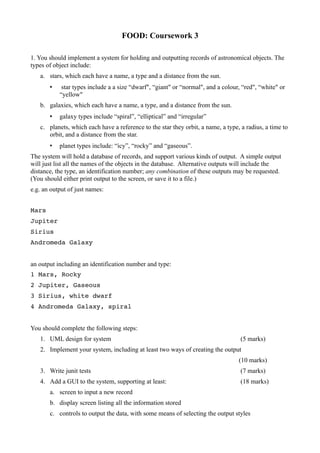Report
Share
Download to read offline

Recommended
Recommended
Unix and Shell Programming,
Q P Code: 60305.
Additional Mathematics I
Q P Code: 60306
Computer Organization and Architecture
Q P Code: 62303
Data Structures Using C
Q P Code: 60303
Discrete Mathematical Structures
Q P Code: 60304
Engineering Mathematics - III
Q P Code: 60301
Soft Skill Development
Q P Code: 603073rd Semester Computer Science and Engineering (ACU) Question papers

3rd Semester Computer Science and Engineering (ACU) Question papersBGS Institute of Technology, Adichunchanagiri University (ACU)
More Related Content
Similar to Coursework 3
Unix and Shell Programming,
Q P Code: 60305.
Additional Mathematics I
Q P Code: 60306
Computer Organization and Architecture
Q P Code: 62303
Data Structures Using C
Q P Code: 60303
Discrete Mathematical Structures
Q P Code: 60304
Engineering Mathematics - III
Q P Code: 60301
Soft Skill Development
Q P Code: 603073rd Semester Computer Science and Engineering (ACU) Question papers

3rd Semester Computer Science and Engineering (ACU) Question papersBGS Institute of Technology, Adichunchanagiri University (ACU)
Similar to Coursework 3 (20)
3rd Semester Computer Science and Engineering (ACU) Question papers

3rd Semester Computer Science and Engineering (ACU) Question papers
PPT on Python - illustrating Python for BBA, B.Tech

PPT on Python - illustrating Python for BBA, B.Tech
TypeScript . the JavaScript developer best friend!

TypeScript . the JavaScript developer best friend!
Reducing Redundancies in Multi-Revision Code Analysis

Reducing Redundancies in Multi-Revision Code Analysis
Coursework 3
- 1. FOOD: Coursework 3 1. You should implement a system for holding and outputting records of astronomical objects. The types of object include: a. stars, which each have a name, a type and a distance from the sun. • star types include a a size “dwarf", “giant" or “normal", and a colour, “red", “white" or “yellow" b. galaxies, which each have a name, a type, and a distance from the sun. • galaxy types include “spiral”, “elliptical” and “irregular” c. planets, which each have a reference to the star they orbit, a name, a type, a radius, a time to orbit, and a distance from the star. • planet types include: “icy”, “rocky” and “gaseous”. The system will hold a database of records, and support various kinds of output. A simple output will just list all the names of the objects in the database. Alternative outputs will include the distance, the type, an identification number; any combination of these outputs may be requested. (You should either print output to the screen, or save it to a file.) e.g. an output of just names: Mars Jupiter Sirius Andromeda Galaxy an output including an identification number and type: 1 Mars, Rocky 2 Jupiter, Gaseous 3 Sirius, white dwarf 4 Andromeda Galaxy, spiral You should complete the following steps: 1. UML design for system (5 marks) 2. Implement your system, including at least two ways of creating the output (10 marks) 3. Write junit tests (7 marks) 4. Add a GUI to the system, supporting at least: (18 marks) a. screen to input a new record b. display screen listing all the information stored c. controls to output the data, with some means of selecting the output styles
- 2. 5. Explain all aspects of your design and demonstrate it working (10 marks) Marks will be awarded for: • Quality of the code design, including use of appropriate design patterns and Java libraries. • Correct working of the system. • Comprehensive use of junit tests. • Use of a variety of widgets within the GUI. (Note: you must write the code for the GUI yourself, using the examples from the module materials; automatically generated code will be awarded 0 marks.) Total: 50 marks 2. Write an essay on agile development processes, relating the ideas to a concrete example of developing a program, such as from section 1.3.4 of the module notes. Describe XP and test-driven development as examples of agile development processes. Summarise those aspects most important for an individual programmer working on a project by him or herself, and which aspects are most important for a large software project, involving many programmers. Use citations and references for any material that you use. Write between 1500 and 2000 words. Marks awarded for: 1. Description of main methodologies. (10 marks) 2. Relation of methodologies to coding example. (7 marks) 3. Summary of differing aspects. (5 marks) 4. Clear English and references. (3 marks) Total: 25 marks
